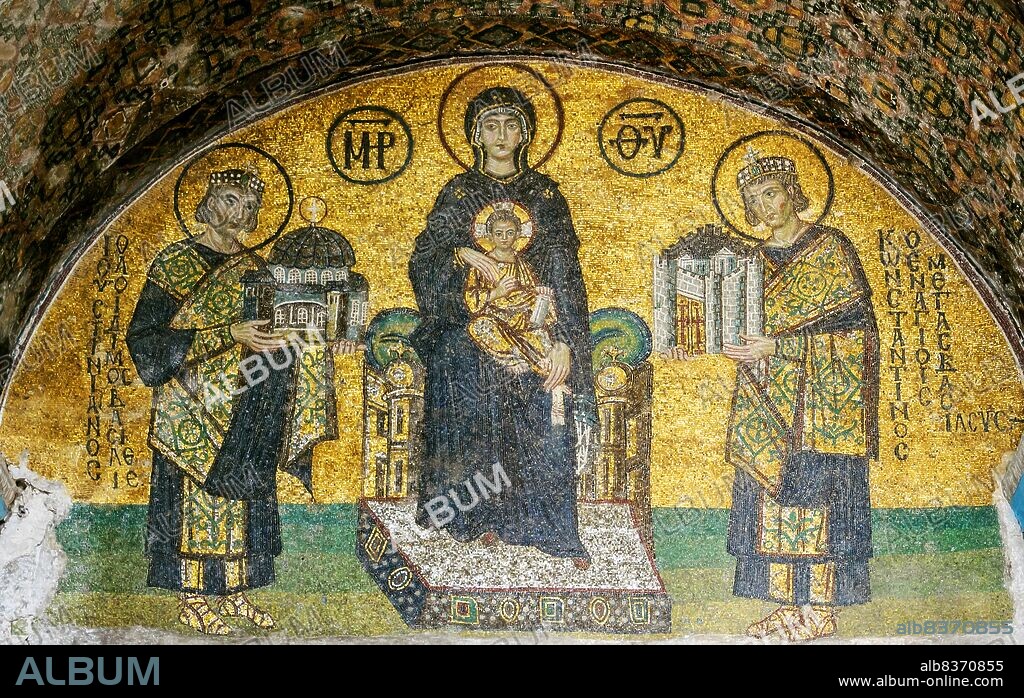alb8370855
Turkey: Mosaic, Hagia Sophia, Istanbul. The Virgin Mary is central, holding the Child Christ on her lap. On her right stands emperor Justinian I, offering a model of Hagia Sophia. On her left, Constantine I, presenting a model of emperor Constantinople. 10th century CE

|
Añadir a otro lightbox |
|
Añadir a otro lightbox |



¿Ya tienes cuenta? Iniciar sesión
¿No tienes cuenta? Regístrate
Compra esta imagen.
Selecciona el uso:

Título:
Turkey: Mosaic, Hagia Sophia, Istanbul. The Virgin Mary is central, holding the Child Christ on her lap. On her right stands emperor Justinian I, offering a model of Hagia Sophia. On her left, Constantine I, presenting a model of emperor Constantinople. 10th century CE
Descripción:
Ver traducción automática
Istanbul's Hagia Sophia (Greek) or Ayasofya (Turkish) was originally constructed as a main Eastern Orthodox church and served in this role from 537 CE until the fall of Constantinople in 1453 (except between 1204 and 1261 when it was converted by the Fourth Crusaders to a Roman Catholic cathedral).
. When the Ottoman Turks under Mehmed II conquered Constantinople, the Hagia Sophia was converted into a mosque and Christian relics and art were either removed or plastered over. It remained a mosque for almost 500 years, before being converted into a museum between 1931 and 1935.
. Famous in particular for its massive dome, it is considered the epitome of Byzantine architecture and influenced the design of numerous mosques in what is now Istanbul.
. When the Ottoman Turks under Mehmed II conquered Constantinople, the Hagia Sophia was converted into a mosque and Christian relics and art were either removed or plastered over. It remained a mosque for almost 500 years, before being converted into a museum between 1931 and 1935.
. Famous in particular for its massive dome, it is considered the epitome of Byzantine architecture and influenced the design of numerous mosques in what is now Istanbul.
Crédito:
Album / Universal Images Group / Pictures From History
Autorizaciones:
Tamaño imagen:
5100 x 3211 px | 46.9 MB
Tamaño impresión:
43.2 x 27.2 cm | 17.0 x 10.7 in (300 dpi)
Palabras clave:
ART • ARTE • ARTES • ASIA • ASIATICO • BIZANTINA • BIZANTINO • CHRISTIAN • CHRISTIANITY • CHURCH • CONSTANTINO I EL GRANDE • CONSTANTINOPLA • CRISTIANA • CRISTIANAS • CRISTIANDAD • CRISTIANISMO • CRISTIANO • CRISTIANOS • CRISTIANSMO • CRISTO • EMPERADOR • ESTAMBUL • FOTOGRAFIA • FRESCO • GOBERNANTE • IGLESIA • ISLAM • JESUCRISTO • JESUS DE NAZARET • JESUS • JUSTINIANO I • JUSTINIANO • KAISER • MADONNA • MARIA VIRGEN • MARIA • MEZQUITA • MONARCA • MOSAICO • MURAL • MUSEO • MUSEOS • MUSEUM • MUSULMAN • NUESTRA SEÑORA • PATRIMONIO DE LA HUMANIDAD UNESCO • PATRIMONIO MUNDIAL DE LA UNESCO • PATRIMONIO MUNDIAL UNESCO • PATRIMONIO UNIVERSAL UNESCO • PINTURA AL FRESCO • PINTURA EN PARED • PINTURA MURAL • RELIGION • RELIGION: CRISTIANA • SANTA SOFIA DE CONSTANTINOPLA • TURCO • TURQUIA • UNESCO • VIRGEN CON EL NIÑO • VIRGEN MARIA • VIRGEN, LA • VIRGIN MARY
 Pinterest
Pinterest Twitter
Twitter Facebook
Facebook Copiar enlace
Copiar enlace Email
Email
